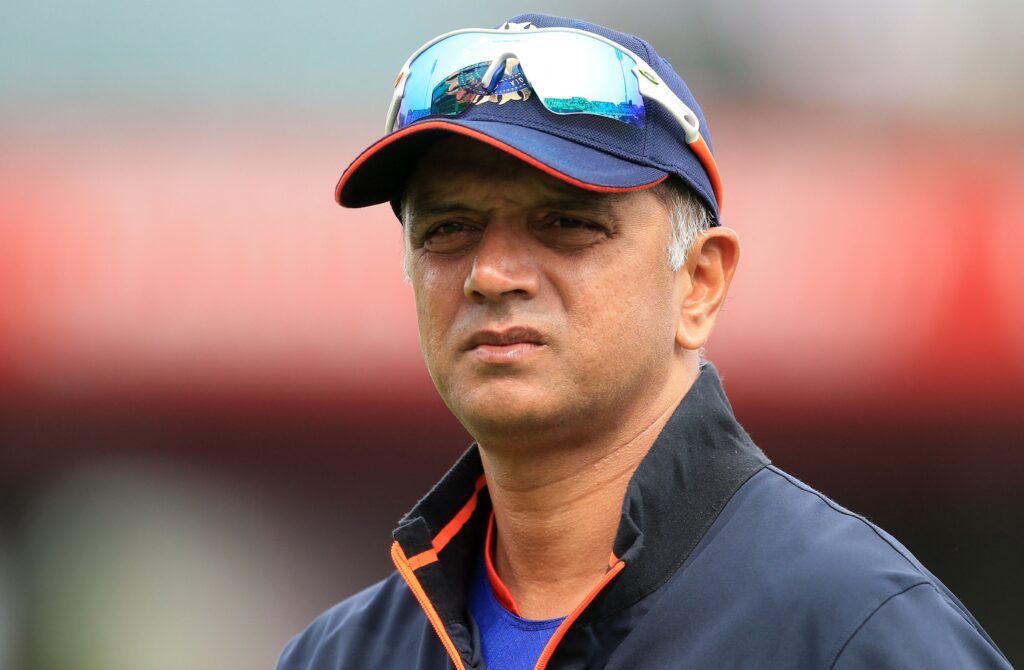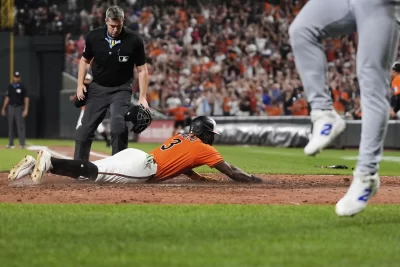
India's head coach Rahul Dravid wathces his players warm up ahead of the final one-day international (ODI) cricket match between England and India at Old Trafford in Manchester on July 17, 2022. - - RESTRICTED TO EDITORIAL USE. NO ASSOCIATION WITH DIRECT COMPETITOR OF SPONSOR, PARTNER, OR SUPPLIER OF THE ECB (Photo by Lindsey Parnaby / AFP) / RESTRICTED TO EDITORIAL USE. NO ASSOCIATION WITH DIRECT COMPETITOR OF SPONSOR, PARTNER, OR SUPPLIER OF THE ECB (Photo by LINDSEY PARNABY/AFP via Getty Images)
Vast swathes of empty saffron seats marked the opening game of the ominously numbered 13th men’s ODI World Cup in Ahmedabad on Thursday, setting off among other topics, a fresh round of debate about the impending slow death of the 50-over format. While proclamations about the format being on ventilator support may be premature at this juncture, there was an acknowledgement from India head coach Rahul Dravid that the sport wouldn’t go back to playing as many games in this ‘middle’ format as they once did.
Dravid, who played as many as 344 ODIs in a 15-year career, hopes the format will continue to be played and valued considering how it still packs in a lot of nuance in its 100-overs of run time.
The statistics lay bare the trend. Since the 2019 World Cup, the full members played a total of 250 ODIs before the England – New Zealand opener on Thursday. The corresponding number in the previous World Cup cycle (2015 – 2019) was 429. In fact, with a total of 367 T20Is in the recent four-year stretch, for the first time there were more T20Is played than ODIs, a significant metric of the changing times.
India’s numbers too conform to this trend. They played the most number of ODIs heading to the marquee event at home — 66 — but even that is still 20 short of the number they played between the World Cups in Australia and England. There is a caveat to the 66 games India have played in that there have been occasions when they’ve sent out a second squad concurrently or played a second-string side amid commitments in the other two formats which have had two world events each in the interim.
“I mean we haven’t played a lot of 50-overs cricket over the last couple of years, that’s one of the things that I have kind of noticed over the couple of years that I have been the coach of the team. Because there were two T20 World Cups that happened and there is always the World Test Championship at the back of every team that you are doing, it’s a cycle that goes on,” Dravid observed, two days out from the start of India’s World Cup campaign.
“Sometimes, this format over the last couple of years, maybe it’s because of Covid, I can’t exactly say, but it’s just felt like we haven’t played a lot of ODI cricket and even when we played it, except over the last few months, we are probably prioritising other things and having to protect our players and manage our players maybe in this format.
“Going forward, I think it’s still an important format, it’s a fantastic format to play. Obviously how much of it is played will be decided by a variety of factors… Obviously with more and more T20 cricket being added on to the calendar, it will make it difficult to potentially have the same number of one-day games that you probably are used to seeing between the 2015 and 2019 calendar. I don’t think we will ever go back to those days but I sincerely hope that we still keep valuing and playing this format…”
Dravid cited the example of Mohammed Siraj’s seven-over spell in the recent Asia Cup Final as well as the Devon Conway – Rachin Ravindra partnership in Ahmedabad to illustrate the fine distinction of the format. “I mean that was really top-class bowling of six [7] overs. In a T20 game you never see that, you would have bowled one or two overs or maybe three overs on a good day.
“But here you got to see a full gamut of his skills and his abilities which I think one-day cricket allows you to do that, allows you to see great spells, it still allows you to see good innings like that we saw from both those left-handers [Conway and Ravindra], it allows to you see a lot of good spin, rotation of strike and a lot of creativity. As a coach and as someone who loves the game of cricket, I want to see this format thrive and do well.”
Games at this year’s World Cup in India could add to Dravid’s ‘full gamut of skill’ assertion with different venues across the length and breadth of the country potentially offering varied challenges. Dravid said it was difficult to put down a number and that adapting to different conditions will be more crucial than reading the pitches right themselves.
“That’s going to be the beauty of this World Cup. So many venues that these matches are going to be played in. So many different wickets on those venues, to be honest some of the squares, you have red soil, black soil, you have a mix of red and black. Each one is going to be unique. I don’t think you can go and say that this is going to be a safe total, that’s not going to be a safe total. You’ve got to just have to adapt and react based on those conditions.
“Ground sizes will be different. We’ll probably play on a relatively bigger ground here in Chennai compared to say when we go to Bangalore or when we go to Delhi. Each venue will be different, we’ll just have to assess and see what it’s like.
“I don’t think that this World Cup is going to be decided by whether you read the pitch correctly, it’s going to be decided on the way you play on those pitches, on the variety of conditions that you are going to get. I think adaptability is going to be a huge challenge in this World Cup and how teams adapt to various venues, conditions and pitches and various bowling that they will have to face. And I think [that] will probably decide how successful teams are.”







